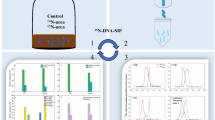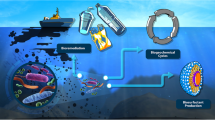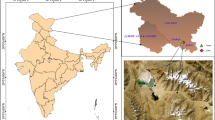Abstract
Pristine and oil-contaminated desert soil samples from Kuwait harbored between 10 and 100 cells g−1 of hydrocarbonoclastic bacteria capable of growth at 50 °C. Enrichment by incubation of moistened soils for 6 months at 50 °C raised those numbers to the magnitude of 103 cells g−1. Most of these organisms were moderately thermophilic and belonged to the genus Bacillus; they grew at 40–50 °C better than at 30 °C. Species belonging to the genera Amycolatopsis, Chelativorans, Isoptericola, Nocardia, Aeribacillus, Aneurinibacillus, Brevibacillus, Geobacillus, Kocuria, Marinobacter and Paenibacillus were also found. This microbial diversity indicates a good potential for hydrocarbon removal in soil at high temperature. Analysis of the same desert soil samples by a culture-independent method (combined, DGGE and 16S rDNA sequencing) revealed dramatically different lists of microorganisms, many of which had been recorded as hydrocarbonoclastic. Many species were more frequent in the oil contaminated than in the pristine soil samples, which may reflect their hydrocarbonoclastic activity in situ. The growth and hydrocarbon consumption potential of all tested isolates were dramatically enhanced by amendment of the cultures with Ca2+ (up to 2.5 M CaSO4). This enhanced effect was even amplified when in addition 8 % w/v dipicolinic acid was amended. These novel findings are useful in suggesting biotechnologies for waste hydrocarbon remediation at moderately high temperature.





Similar content being viewed by others
References
Al-Awadhi H, Al-Mailem D, Dashti N, Khanafer M, Radwan SS (2012) Indigenous hydrocarbon-utilizing bacterioflora in oil-polluted habitats in Kuwait, two decades after the greatest man-made oil spill. Arch Microbiol 194:689–705
Al-Awadhi H, Dashti N, Khanafer M, Al-Mailem D, Ali N, Radwan SS (2013) Bias problems in the molecular-based analysis of environmental bacterial communities: a representative study on oil-utilizing bacteria. Springer Plus 2:369
Ali N, Dashti N, Al-Mailem D, Eliyas M, Radwan SS (2012) Indigenous soil bacteria with the combined potential for hydrocarbon-consumption and heavy-metal-resistance. Environ Sci Pollut Res 19:812–820
Al-Mailem DM, Sorkhoh NA, Al-Awadhi H, Eliyas M, Radwan SS (2010) Biodegradation of crude oil and pure hydrocarbons by extreme halophilic archaea from hypersaline coasts of the Arabian Gulf. Extremophiles 14:321–328
Al-Mailem DM, Eliyas M, Radwan SS (2013) Bioremediation of oily hypersaline soil and water via potassium and magnesium amendment. Can J Microbiol 59:837–844
Al-Mailem DM, Eliyas M, Radwan SS (2014) Enhanced bioremediation of oily hypersaline coastal areas in Kuwait via vitamin-fertilization. Environ Sci Pollut Res 21:3386–3393
Altschul SF, Madden TL, Schaffer AA, Zhang J, Zhang Z, Miller W, Lipman DJ (1997) Gapped BLAST and PSI-BLAST: a new generation of protein database search programs. Nucleic Acids Res 25:3389–3402
Feitkenhauer H, Müller R, Märkl H (2003) Degradation of polycyclic aromatic hydrocarbons and long chain alkanes at 60–70 °C by Thermus and Bacillus spp. Biodegradation 14:367–372
Hadad D, Geresh S, Sivan A (2005) Biodegradation of polyethylene by the thermophilic bacterium Brevibacillus borstelensis. J Appl Microbiol 98:1093–1100
Kato T, Haruki M, Imanaka T, Morikawa M, Kanaya S (2001) Isolation and characterization of long-chain-alkane degrading Bacillus thermoleovorans from deep subterranean petroleum reservoirs. J Biosci Bioeng 91:64–70
Lei W, Yun T, Shuo W, Rulin L, Muzhi L, Yan Z, Fenglai L, Lu F (2006) Isolation and characterization of a novel thermophilic Bacillus strain degrading long-chain n-alkanes. Extremophiles 10:347–356
Loginova LG, Bogdanova TI, Seregina IM (1981) Growth of obligate thermophilic bacteria in a medium with paraffin. Microbiologiya 50:49–54
Marchant R, Sharkey FH, Banat IM, Rahman TJ, Perfumo A (2006) The degradation of n-hexadecane in soil by thermophilic Geobacilli. FEMS Microbiol Ecol 56:44–54
Margesin R, Schinner F (2001) Biodegradation and bioremediation of hydrocarbons in extreme environments. Appl Microbiol Biotechnol 56:650–663
Mateles RI, Baruah JN, Tannenbaum SR (1967) Growth of a thermophilic bacterium on hydrocarbons: a new source of single-cell protein. Science 157:1322–1323
Meintanis C, Chalkou KI, Kormas KA, Karagouni AD (2006) Biodegradation of crude oil by thermophilic bacteria isolated from a volcano island. Biodegradation 17:105–111
Nazina TN, Tourova TP, Poltaraus AB, Novikova EV, Grigoryan AA, Ivanova AE, Lysenko AM, Petrunyaka VV (2001) Taxonomic study of aerobic thermophilic bacilli: descriptions of Geobacillus subterraneus gen. nov., sp. nov. and Geobacillus uzenensis sp. nov. from petroleum reservoirs and transfer of Bacillus stearothermophilus, Bacillus thermocatenulatus, Bacillus thermoleovorans, Bacillus kaustophilus, Bacillus thermoglucosidasius and Bacillus thermodenitrificans to Geobacillus as the new combinations G. stearothermophilus, G. thermocatenulatus, G. thermoleovorans, G. kaustophilus, G. thermoglucosidasius and G. thermodenitrificans. Int J Syst Evol Microbiol 51:433–446
Perfumo A, Banat IM, Marchant R, Vezzulli L (2007) Thermally enhanced approaches for bioremediation of hydrocarbon-contaminated soils. Chemosphere 66:179–184
Perry JJ (1985) Isolation and characterization of thermophilic hydrocarbon utilizing bacteria. Adv Aquat Microbiol 3:109–139
Phillips WE, Perry JJ (1976) Thermomicrobium fosteri sp. nov., a hydrocarbon utilizing obligate thermophile. Int J Syst Bacteriol 26:220–225
Poli A, Romano I, Caliendo G, Nicolaus G, Orlando P, Falco A, Lama L, Gambacorta A, Nicolaus B (2006) Geobacillus toebii subsp. decanicus subsp. nov., a hydrocarbon-degrading, heavy metal resistant bacterium from hot compost. J Gen Appl Microbiol 52:223–234
Poli A, Guven K, Romano I, Pirinccioglu H, Guven RG, Euzeby JP, Matpan F, Acer O, Orlando P, Nicolaus B (2012) Geobacillus subterraneus subsp. aromaticivorans subsp. nov., a novel thermophilic and alkaliphilic bacterium isolated from a hot spring in Sirnak, Turkey. J Gen Appl Microbiol 58:437–446
Polz MF, Cavanaugh CM (1998) Bias in template-to-product ratios in multitemplate PCR. Appl Environ Microbiol 64:3724–3730
Radwan SS (2008) Microbiology of oil-contaminated desert soils and coastal areas in the Arabian Gulf region. In: Dion P, Nawtiyal CS (eds) Microbiology of extreme soils, chapter 13. Springer, New York, pp 275–298
Radwan SS, Sorkhoh NA, Felzmann H, El-Desouky AF (1996) Uptake and utilization of n-octacosane and n-nonacosane by Arthrobacter nicotianae KCC B35. J Appl Bacteriol 80:370–374
Rahman TJ, Marchant R, Banat IM (2004) Distribution and molecular investigation of highly thermophilic bacteria associated with cool soil environments. Biochem Soc Trans 32:209–213
Santegoeds CM, Ferdelman TG, Muyzer G, Beer D (1998) Structural and functional dynamics of sulfate-reduction populations in bacterial biofilms. Appl Environ Microbiol 64:3731–3739
Schäfer H, Muyzer G (2001) Denaturing gradient gel electrophorasis in marine microbial ecology. Methods Microbiol 30:425–468
Shieh WY, Jean WD, Lin YT, Tseng M (2003) Marinobacter lutaoensis sp. nov., a thermotolerant marine bacterium isolated from a coastal hot spring in Lutao, Taiwan. Can J Microbiol 49:244–252
Sipos R, Székely AJ, Palatinsky M, Révész S, Marialigeti K, Nikolausz M (2007) Effect of primer mismatch, annealing temperature and PCR cycle number on 16S rRNA gene-targeting bacterial community analysis. FEMS Microbiol Ecol 60:341–350
Sorkhoh NA, Ghannoum MA, Ibrahim AS, Stretton RJ, Radwan SS (1990) Crude oil and hydrocarbon degrading strains of Rhodococcus rhodochrous isolated from soil and marine environments in Kuwait. Environ Pollut 65:1–17
Sorkhoh NA, Ibrahim AS, Ghannoum MA, Radwan SS (1993) High temperature hydrocarbon degradation by Bacillus stearothermophilus from oil polluted Kuwaiti desert. Appl Microbiol Biotechnol 39:123–126
Yu W, Dodds WK, Banks K, Skalsky J, Staruss E (1995) Optimal staining and sample storage time for direct microscopic enumeration of total and active bacteria in soil with two fluorescent dyes. Appl Environ Microbiol 61:3367–3372
Zarilla KA, Perry JJ (1984) Thermoleophilum album gen. nov. and sp. nov., a bacterium obligate for thermophily and n-alkane substrates. Arch Microbiol 137:286–290
Zarilla KA, Perry JJ (1987) Bacillus thermoleovorans, sp. nov., a species of obligately thermophilic hydrocarbon utilizing endospore-forming bacteria. Syst Appl Microbiol 9:258–264
Acknowledgments
The work was supported by the University of Kuwait, Research Grant SL 02/12. Thanks are due to the SAF unit and GRF, Kuwait University for providing GLC (GS 02/01) and Genetic analyzer (GS 01/02) facilities.
Author information
Authors and Affiliations
Corresponding author
Additional information
Communicated by M. da Costa.
Electronic supplementary material
Below is the link to the electronic supplementary material.
Rights and permissions
About this article
Cite this article
Al-Mailem, D.M., Kansour, M.K. & Radwan, S.S. Moderately thermophilic, hydrocarbonoclastic bacterial communities in Kuwaiti desert soil: enhanced activity via Ca2+ and dipicolinic acid amendment. Extremophiles 19, 573–583 (2015). https://doi.org/10.1007/s00792-015-0739-0
Received:
Accepted:
Published:
Issue Date:
DOI: https://doi.org/10.1007/s00792-015-0739-0




